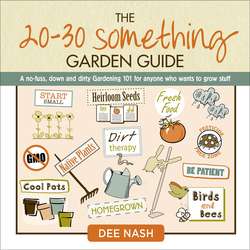Читать книгу The 20-30 Something Garden Guide - Dee Nash - Страница 19
На сайте Литреса книга снята с продажи.
Tools of the Trade
ОглавлениеContainers should be at least 18 to 24 inches wide and 12 to 16 inches deep to provide plenty of room for your plants. One benefit to using larger containers is they don’t dry out as quickly as smaller ones. Small pots can look nice tucked into small spaces, though. It helps if you line porous containers with some type of material that retains water. I sometimes use a layer of sphagnum moss in mine around the edges, but I have also used bubble wrap. I like moss better because it's natural.
There are several different kinds of containers to choose from. Here’s what you need to know to pick the best ones for your garden:
TERRA COTTA. Terra cotta is porous, so it heats up quickly and drains rapidly. In a hot climate, it can dry out too quickly. However, it is wonderful for large, top-heavy plants that need a sturdy pot.
PLASTIC. Don’t belittle the humble plastic container. While it might not be the sportiest one on the block, it will get you through your first and probably second season just fine. Plastics with bisphenol A (BPA) have been in the news recently because of their potential link to cancer. There is debate about whether you should choose BPA-free plastic to grow vegetables. BPA is understandably controversial, and research is ongoing. For my own garden, I use organic practices throughout; last year I chose food-grade plastic buckets to grow my potatoes. There’s still scientific discussion about whether BPA leaches into growing vegetables. That’s not to say that it doesn’t, though. To be safe, I would choose food-grade plastic or a completely different type of container to grow fruit and vegetables, just in case.
INSULATED CONTAINERS. These are an excellent medium for flowers. However, since they are not made of food-grade plastic, I wouldn’t use them to grow anything I’d want to eat. They also hold moisture – not ideal in rainy climates, but can be very beneficial in dry climates.
GLAZED CERAMIC CONTAINERS. Glazed containers are a good choice because the glazing retains moisture. But, they are heavy and can crack like terra cotta if left outside over winter. Glazed containers can also be pricey, so it’s best to collect them a few at a time. I grow most of my plants in cobalt blue glazed pots I’ve gathered over the years.
CONCRETE AND HYPERTUFA. These are additional container choices. Minerals that bleed out of concrete tend to make soil more alkaline. I’ve never had problems with this, but if you grow a crop like blueberries you will probably need to add sulphur to acidify the soil.
METAL CONTAINERS. For sheer modern, architectural style, nothing beats the silvery goodness and contemporary charm of galvanized steel stock tanks, or other lead-free, metal containers. They make great small ponds, too.
UPCYCLED ITEMS. I’ve seen plants grown in everything from bathtubs to plastic storage bins. Use your imagination to create a garden that’s practically free!
Container selections are nearly endless. Whatever type you pick, it’s good to be aware of the pluses and minuses of each material before you choose.
